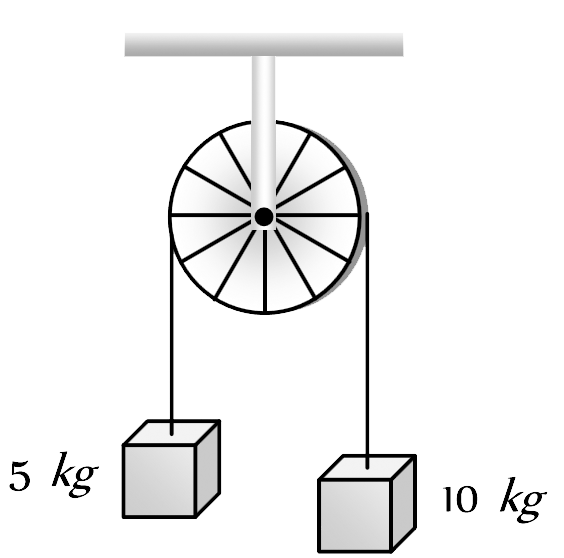In the arrangement shows in fig. if the surface is smooth then find out acceleration of the block m2.
 Solution in Gujrati
Solution in Gujrati
Let accelration of m2 be a then acceleration of m1 will be 2a.
for m1:T=m1(2a) and for m2:m2g−2T=m2a
⇒m2g−4m1a=m2a⇒a=m2g4m1+m2
Topper's Solved these Questions
- NEWTONS LAWS OF MOTIONBOOK - ALLEN CHAPTER - NEWTONS LAWS OF MOTIONEXERCISE - EXERCISE-I
52 Videos
- NEWTONS LAWS OF MOTIONBOOK - ALLEN CHAPTER - NEWTONS LAWS OF MOTIONEXERCISE - EXERCISE-II
112 Videos
- NEWTONS LAWS OF MOTIONBOOK - ALLEN CHAPTER - NEWTONS LAWS OF MOTIONEXERCISE - EXERCISE-III
28 Videos
- NEWTON'S LAWS OF MOTION & FRICTIONBOOK - ALLEN CHAPTER - NEWTON'S LAWS OF MOTION & FRICTIONEXERCISE - EXERCISE (JA)
4 Videos
- RACEBOOK - ALLEN CHAPTER - RACEEXERCISE - Basic Maths (Wave Motion & Dopplers Effect) (Stationary waves & doppler effect, beats)
25 Videos
Similar Questions
USS 150) Two masses of 5 kg and 10 kg are connected to a pulley as shown. What will be the acceleration of the system (g= acceleration due to gravity)

View SolutionA particle is in straight line motion with uniform velocity A force is not required
View SolutionAssertion: The driver in a vechicle moving with a constant speed on a straight road is in a non-inertial frame of referance.
Reason: A reference frame in which Newton's laws of motion are applicable is non-inertial.
View SolutionA piece of wire is bent in the shape of a parabola y=kx2 (y-axis vertical) with a bead of mass m on it. The bead can slide on the wire without friction. It stays at the lowest point of the parabola when the wire is at rest. The wire is now accelerated parallel to the x-axis with a constant acceleration a. The distance of the new equilibrium position of the bead, where the bead can stay at rest with respect to the wire, from the y-axis is:
View SolutionThe frequency of a radar is 780 MHz. After getting reflected from an approaching aeroplane, the apparent frequency is more than the actual frequency by 2.6 kHz. The aeroplane has a speed of
View SolutionTwo block of masses m_(1) and m_(2) are placed side by side on a smooth horizontal surface as shown in fig. A horizontal force F is applied on the block . (a) Find the acceleration of each block. (b) Find the normal reaction between the two blocks.
View SolutionIn the arrangement shown in fig. The strings are light and inextensible. The surface over which blocks are placed is smooth. Find:

(a) the acceleration of each block.
(b) the tension in each string.
View SolutionIn fig Block m_(2) is loaded on block m_(1) . If there is no relative sliding between the block and the inclined plane is smooth , find the friction force between the block
View SolutionTwo blocks of masses m_(1) and m_(2) interconnect with a spring of stiffness K , are kept on as smooth horizontal surface. Find out the ratio of velocity, displacement, kinetic energy and acceleration block with mass m_(1) of block with mass m_(2) .
View SolutionIn the fig, find the acceleration of m_(1) and m_(2) .
View SolutionFigure shows a block of mass 2m sliding on a block of mass m. Find the acceleration of each block . ( All surface are smooth )

View SolutionMass m_(1)" & "m_(2) are placed on a rough inclined plane as shown in figure. Find out the acceleration of the blocks and contact force in between these surface.
View SolutionA constant force F=m2g/2 is applied on the block of mass m1 as shown in fig. The string and the pulley are light and the surface of the table is smooth. The acceleration of m1 is :

View SolutionFig. shows a block of mass m1 resting on a smooth surface. It is connected to a mass m2 by a string passing over a massless and frictionaless pulleys m2>m1. The acceleration of the hanging mass m2 is :

View SolutionIn the given arrangement all surfaces are smooth. What acceleration should be given to the system, for which the block m_(2) doesn't slide down?
View SolutionIn the fig, find the acceleration of m_(1) and m_(2)
View Solution
